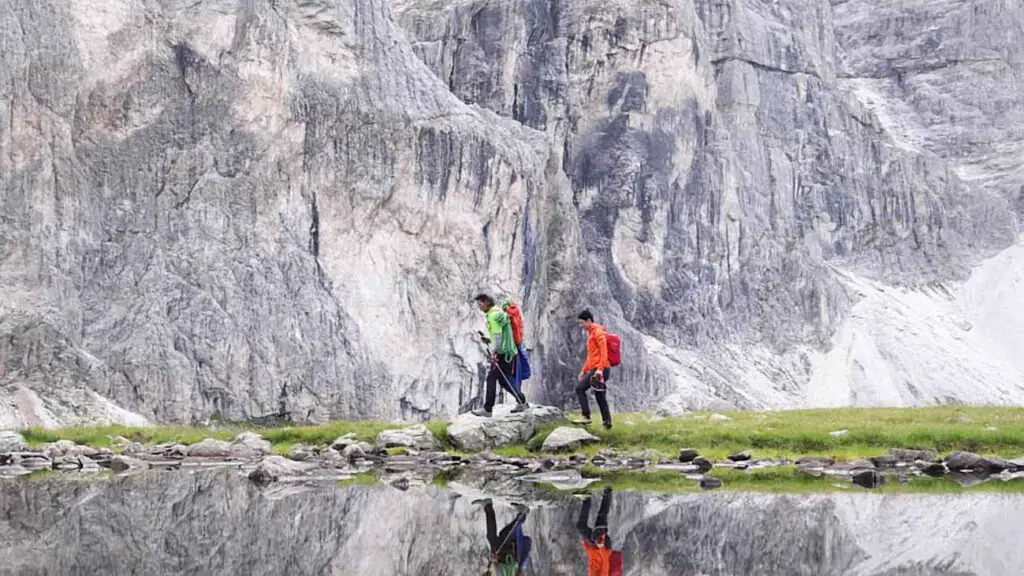Let me say, bears are truly fascinating animals, just like the Tatra Mountains are. One of the largest land creatures, Tatra mountains bears can weigh up to a whopping 350 kg. I think it’s pretty obvious that getting too close to these guys can be dangerous. But don’t be fooled by their stocky, clumsy appearance.
These animals are incredibly agile and fast. Believe it or not, they can run, jump, swim, and climb trees and rocks with ease. In a quick sprint, they can reach speeds over 60 km/h. I am convinced that their skills in the Tatras rival those of experienced mountaineers.
Currently, there are about 50-60 bears living in the Tatra Mountains, with a dozen or so residing on the Polish side. Female bears give birth to one to three cubs every two years during winter and care for them for a year and a half.
The young bears follow their mother everywhere, gradually moving further away as they grow. For instance, in April-May, they might stay up to 50 m away, and by autumn, they could be 100-200 m away. In the Polish part of the Tatra Mountains, you can observe one to three bears with cubs each year.
↳ Before you head to Tatra Park, I highly recommend reading my complete guide to Tatra Mountains. I showcase the most scenic places you won't want to miss. Make sure to check it out, so you don't overlook anything interesting: Tatra Mountains – An Insider’s Guide to All Attractions and Info
- Before you start your trip, you should also read this article. You will learn that the most dangerous are the smallest animals: A Guide to the Most Dangerous Animals Found in Poland.
Be Cautious, Bears Can Break Into Cars

If you’re visiting the Tatra Mountains, you need to know that bears have been known to break into cars left in parking lots, especially if there’s a fragrant food supply in the trunk. This type of behavior has been recorded in the Tatra Mountains in recent years.
It usually happens around the summer and autumn months, when the animals are trying to accumulate reserves for the winter.
I know bears might seem like cautious animals, but they’re not skittish. When disturbed, they stand on their hind legs to observe their surroundings. If there’s no threat, they usually move out of the way.
PRO TIP: If you have a group of people, for a small fee, you may hire local Tatra guide who will not only take care of you during your hike, but also present you Tatra Mountains in a way you would experience alone. Click the link below to find out more:
- (€) ❤️ Tatra Mountains Hiking Guide: With a local guide, you will walk along trails that offer incredible panoramic views over Zakopane, and see Siklawica Waterfall, and Giewont Summit up close. During the walk, you will enjoy fun facts about the local area.
But let’s get back to the bears. Research shows that bears actually notice the presence of people more often than we realize. A bear can lie just several dozen meters from a trail for hours, simply watching tourists go by.
So if you want to experience the beauty of the Tatra Mountains, always be aware of your surroundings, and remember to secure your food and belongings properly.
Herbivore or Predator?
The bear is the largest predatory mammal in Europe. They can weigh anywhere from 100 to 400 kg, with some individuals even larger than that. But here’s a surprising fact – this masive predator is actually more of a herbivore by preference.
It is worth to say that bears are predators only by coercion, and they would rather munch on plants than hunt for prey. If they do hunt, their victims are usually wasp larvae and ants. However, there are bears that enjoy hunting from time to time, and when they do, almost every species of land mammal in the Tatra Mountains, and even some birds, can fall prey to them.
- You should also read about other polish predator: Meet the White-Tailed Eagle: Poland’s National Animal
Occasionally, a bear specializing in livestock hunting may appear in the Tatras and surrounding areas. But the vast majority of a bear’s diet consists of plants. In spring, they feast on fresh grasses and herbs, while in summer and autumn, they savor all kinds of fruit. In the Tatra Mountains, they mainly enjoy blueberries, raspberries, cowberries, and rowanberies.
I believe it’s important to mention that bears have an excellent sense of smell and hearing, but slightly weaker eyesight. This difference in sensory perception makes their view of the world quite distinct from ours. Such sensitivity is an excellent adaptation for life in a forest environment with limited visibility.
A bear’s sense of smell can detect chamois buried in an avalanche or even candy wrappers left on a trail hours earlier.
Despite their size, bears are agile and incredibly fast. They can run at speeds of up to 60 km/h, swim well, and climb trees with ease. So if you find yourself exploring the Tatra Mountains, always be aware of your surroundings and keep a respectful distance from these amazing animals.
Staying Safe with a Local Guide
As I already showed you, embarking on a trip across the Tatra Mountains might be adrenaline-pumping experience. But, trying this without a local guide, especially with the bears around, might put you on the edge of danger.
Now, you might ask why a local guide, right? Well, I can tell you they’re pros in navigating the rough terrains and finding the safest routes. Their eagle eyes can spot bear signs that you or I would easily overlook.

With a guide, you won’t just dodge the risks but also learn cool stuff about the local plants, animals, and rocks. So, hiring a local guide isn’t just about keeping safe. It opens the door to a richer, deeper adventure in the Tatra Mountains. If you want an unforgettable trip, trust me, a local guide is your best bet.
What to Do If You Meet a Bear in the Tatra Mountains
At this point I am sure you might be wondering, „What if I meet a bear?” Remember, bears are cautious animals but not timid. If disturbed, they stand on their hind legs to observe their surroundings. In case you encounter a bear, keep calm. Calmly walk away without making any sudden movements, and never approach the animal. Even a disturbed bear usually calms down when you show the desire to leave. Bear attacks are extremely rare, but they can happen in certain situations:
- When you unexpectedly surprise an animal at close range, e.g., while it’s foraging in brush or resting
- When you approach a bear while it’s feeding, especially on dead prey
- When you accidentally get between a mother and her cubs, which can happen involuntarily as cubs can be more than 100 meters away from their mother by the end of summer
A Year in the Life of a Tatra Mountain Bear
To better understand these creatures, let’s take a quick look at a bear’s yearly activities:
- Winter (December–March): Bears hibernate in their lairs
- Spring (March–April): Bears search for deceased deer and chamois from winter and eat young plants
- Mating season: Females leave their one-and-a-half-year-old cubs and mate with males for 2-3 weeks
- Summer and early autumn (July–October): Bears fatten up and accumulate fat reserves
- Late autumn (November): Bears prepare their dens and get ready for hibernation
Every other year, female bears give birth to 1-3 cubs in winter and care for them for 1.5 years. Cubs follow their mother everywhere, gradualy moving farther away, up to 100-200 m in autumn. In the Polish part of the Tatra Mountains, one to three female bears with cubs are observed each year.
Tips for Visiting the Bear Sanctuary
If you’re planning to visit the bear sanctuary, here are some important rules to follow:
- Remember that you’re temporarily in the bears’ territory, so stick to marked trails
- If you encounter a bear, stay calm and walk away slowly
- Never approach a bear
- Be aware that leaving human food can be deadly for bears
- Do not leave any trash on the trail, even candy wrappers. Take organic waste with you, as it can be a big temptation for animals
- Before leaving your car in the parking lot, remove all food and ensure there’s no lingering smell.
Most Common „Teddy Bear” Hangouts in the Tatra Mountains
While wandering in the mountains, you should be prepared to potentially encounter a bear, even though such unexpected meetings are rare. Bears likely have their dens in areas like the Pyszna, Tomanowa, and Waksmundzka valleys. Other favorite valleys for bears include the popular Jaworzynka nad Kuźnicami and the Slovak Valley of Biała Woda, along with smaller valleys (closed to tourist traffic) extending from it.
Here are some other places where bears are often spotted:
- Chochołowska Valley
- Polana Roztoka
- Black trail from Brzeziny to Hala Gąsienicowa
- Cyrhla area
- Hala Kondratowa area
Being aware of these locations can help you stay alert and prepared for a potential bear encounter. Remember to follow the safety tips mentioned earlier to ensure a safe and enjoyable experience in the Tatra Mountains.
Bear-Watching in Safe Environment
Do you know what a bear-watching tour is? Well, let me say, it’s just as cool as it sounds! It’s usually a quick trip to a special hideout where you can see bears in their natural habitat. And no, I’m not talking about a zoo, sanctuary, or an enclosed area. You get to watch these majestic creatures in the wild, just as nature intended.

You can check more information on the provider’s website.
You’d probably be starting around 5 PM or 6 PM. The entire experience lasts about 4-8 hours. I know, it might seem like a long time, but trust me, it flies by. Sometimes, you might want to go bear watching outside these days. If that’s the case, don’t worry. All you need to do is get in touch with us and we’ll see what we can do.
Here’s how it usually goes:
- Guide takes you to a forest. The real deal, not a theme park!
- Next, we you walk to a specially designed bear hide. I believe it’s part of the thrill!
- Finally, you sit tight and wait for the stars of the show – the bears.
What Happens Next?
Now, I can tell you this from experience – most of the time, the bears arrive just a few minutes after you reach. I am convinced it’s their way of saying welcome. But sometimes, if you’re really lucky, the bears might be there already when you arrive.
If you happen to walk into such a situation, remember to keep your excitement in check. You wouldn’t want to scare these amazing creatures away, would you? So, maintain your calm, stay quiet, and get ready for an unforgettable bear-watching experience.
↳ Book the best bear-watching trip in Tatra Mountains by clicking here!
Chamois, Bears, and Marmots in the Tatra Mountains – Estimated Populations
Giving an exact number of animals for a specific species is difficult, as they are always on the move. For the same reason, it’s hard to determine how many of them live in Slovakia and how many in Poland. However, we can provide approximate numbers for the species mentioned.
Chamois (Rupicapra rupicapra tatrica)
Based on data from last year’s spring count, the entire chamois population consisted of about 950 individuals. Among them were 149 males and 280 females, with 245 juveniles and the rest unidentified. It’s estimated that there are about 359 chamois on the Polish side and 591 on the Slovak side.
Bear (Ursus arctos)
Counting bears is more challenging, as they are constantly on the move and travel far, even beyond the borders of the mountains. It is estimated that there are about 60-80 bears in the Tatra Mountains, with a few residing on the Polish side.
Marmot (Marmota marmota latirostris)
The Tatra marmot has faced the risk of extinction many times and is currently classified as an endangered species. It’s estimated that around 700-800 individuals live in the Tatra Mountains, with about 200 of them in Poland.
References:
- https://pl.wikipedia.org/wiki/Nied%C5%BAwied%C5%BA_brunatny
- https://ezakopane.pl/turystyka/porady/gdy-spotkasz-niedzwiedzia-na-szlaku/
- https://portaltatrzanski.pl/wiedza/przyroda/ile-kozic-niedzwiedzi-i-swistakow-zyje-w-tatrach,568




